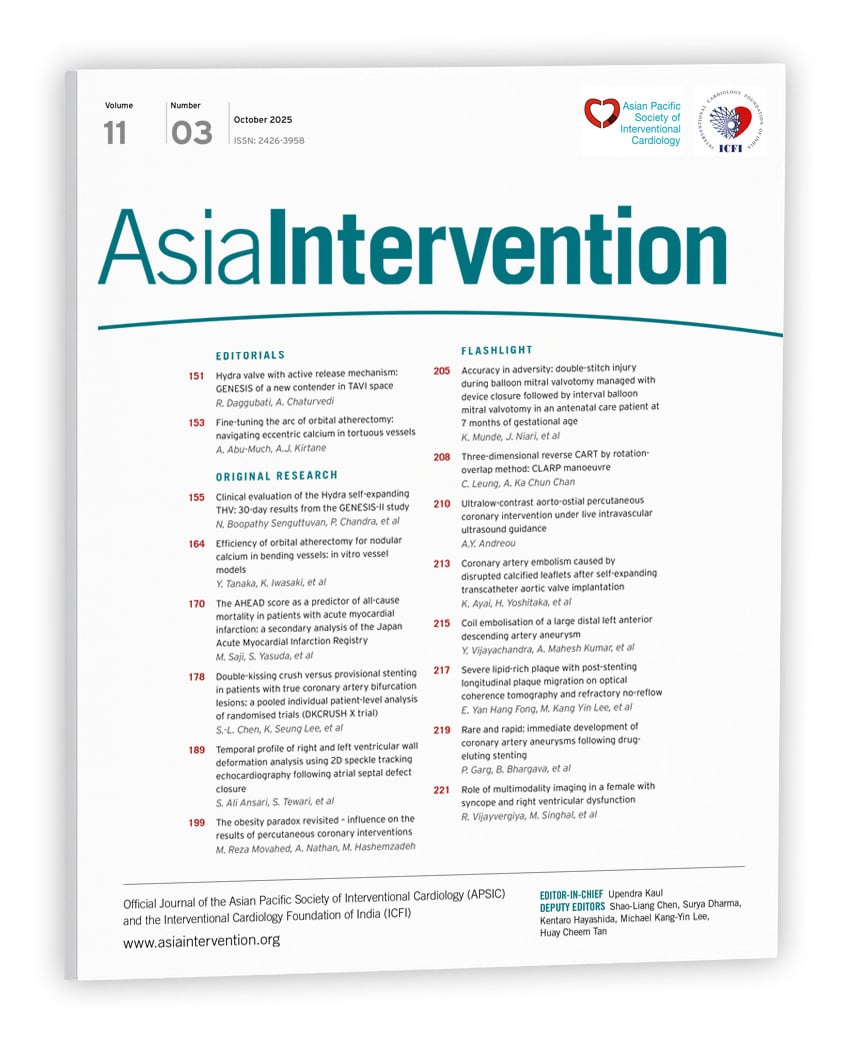An 84-year-old female with a history of percutaneous coronary intervention to the left anterior descending artery (LAD) presented with worsening exertional dyspnoea due to severe aortic stenosis. Transthoracic echocardiography (TTE) showed a peak velocity of 4.06 m/s, a mean pressure gradient of 35 mmHg, and an aortic valve area of 0.78 cm². Preprocedural computed tomography (CT) showed the annulus perimeter and area were 64.1 mm and 308 mm², respectively. Although the left coronary height was relatively low at 9.5 mm, CT analysis suggested a low risk of coronary obstruction due to a sufficient sinus of Valsalva space (Supplementary Figure 1). Given the patient’s advanced age, transcatheter aortic valve implantation (TAVI) with a 26 mm Evolut FX valve (Medtronic) was performed via the right femoral artery. Following predilatation with an 18 mm balloon, the valve was implanted at an acceptable depth, and transoesophageal echocardiography showed trivial paravalvular leakage. The final angiogram confirmed no coronary obstruction (Moving image 1). On day 1 post-TAVI, the patient developed chest discomfort, and blood tests revealed elevated cardiac enzymes. Electrocardiography showed new-onset complete left bundle branch block, and TTE indicated regional wall motion abnormalities in the LAD territory, suggesting acute ischaemia. Emergent CT ruled out valve embolisation, coronary ostial obstruction, and sinus sequestration but revealed a calcified structure in the mid-LAD (Figure 1A). Emergent coronary angiography using a 6 Fr Judkins Left 3.5 catheter confirmed mid-LAD flow limitation due to embolisation (Figure 1B, Moving image 2). After advancing a 0.014 inch guidewire to the LAD, intravascular ultrasound identified a calcified embolic structure (Figure 1C). Despite multiple aspiration attempts using a 6 Fr aspiration catheter, we were unable to aspirate the thrombus. Even after excimer laser coronary angioplasty, the embolus remained unaspirated. Ultimately, it was pushed into a prior stent, which necessitated bailout stenting with a 3.0×18 mm XIENCE Skypoint stent (Abbott) to anchor the embolus within the stent (Moving image 3). The final angiogram confirmed coronary flow improvement without complications (Figure 1D, Moving image 4). Coronary obstruction is a rare but life-threatening TAVI complication, typically occurring within 7 days after TAVI due to valve displacement1. In this case, coronary embolisation from disrupted calcified native leaflets was the cause; this is an uncommon mechanism. Given the difficulty in predicting this event, early ischaemia detection and prompt intervention are crucial. 
Figure 1. Imaging and angiographic findings. A) Emergent computed tomography imaging showed the calcified structure (yellow arrow) at the previously implanted stent (red arrows). B) Emergent coronary angiography showed the calcified embolic structure (yellow arrow) at the proximal end of the prior stent (red arrows). C) Intravascular ultrasound imaging confirmed the calcified structure (yellow arrow). D) Final angiography showing the bailout stent (blue dotted line).
Conflict of interest statement
A. Hiraoka, T. Yoshida, and H. Yoshitaka received honoraria from Medtronic and Abbott. A. Hirohata received honorarium from Abbott. The other authors have no conflicts of interest associated with this manuscript to declare.

